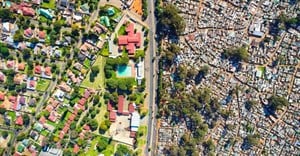
Subscribe & Follow
South African policies go some way to tackling poverty and inequality. But more is needed

The government has committed itself to addressing poverty, inequality and social exclusion – understood as disadvantage by gender, race, disability or place. The mandate is laid out in the Constitution and in the government’s National Development Plan. The plan was adopted in September 2012 as a blueprint for eliminating poverty and significantly reducing inequality by 2030.
But do the country’s laws, policies and strategy documents show exactly how poverty, inequality and social exclusion will be tackled?
To answer this question, researchers at the Centre for Social Development in Africa undertook an extensive review commissioned by the National Development Agency. We explored how policymakers and legislators have faced these systemic challenges in drafting their documents.
We reviewed 501 legislative, policy and strategy documents under the Medium Term Strategic Framework Outcomes, the implementation strategy of the National Development Plan (2014-2019). The documents cover education, health, safety and security, economic growth and employment, skills, infrastructure, rural development, human settlements, local government, environment, public service, social protection, nation building and social cohesion.
We reviewed each document to determine the number of references to poverty, inequality, social exclusion, gender, race, disability, youth unemployment and spatial inequality. Then we analysed whether the references were generic or specific.
We considered whether the documents showed an understanding of the issues and looked for solutions.
Our findings reveal that there is at least some engagement with poverty, inequality and social exclusion in all governmental sectors. But it’s inconsistent. We identified steps that could improve progress.
Our findings
We found that 10% of legislative documents and more than half of all policy and strategy documents mentioned poverty, inequality, social exclusion, gender, race, disability and spatial disparities at least once.
The social protection sector showed the highest average number of references to poverty (58), inequality (70) and social exclusion (116) in its documents. The public service sector showed the lowest number of references.
We also discovered that there are many more references in policy and strategy documents than in legislative documents.
More references don’t mean deeper engagement with these issues. In some cases, the issues are not critically analysed. References to poverty, inequality and social exclusion must explain how they affect each law and policy. They should also offer strategic interventions.
Some sectors do take this holistic approach to policymaking. In the health sector, for example, we found that some policy and strategy documents examine the connection between poverty, inequality and health outcomes. The Breast Cancer Control Policy, for instance, identifies transport as a constraint to accessing health services.
We also found that references to gender and spatial disparities are most common when addressing social exclusion. But references to population groups, disability and youth who are not in education or training are inconsistent across the board.
The gap between policy and practice
Policies matter and can make a real difference. But on their own they are insufficient. They must be implemented. Change happens through stakeholders and processes.
More needs to be done to include poverty, inequality and social exclusion in all policymaking. Here are some remedies that arose from our research:
- Recognition of poverty, inequality and social exclusion cannot be limited to policy and strategy documents. It must be reflected in legislative documents because laws are binding.
- Policymaking institutions must take ownership of the national mandate. Each government department must develop solutions. They cannot simply rely on the National Development Plan to reduce poverty and inequality.
- Government departments could develop a toolkit based on shared good practice. This would help to translate documents into action. Documents must be grounded in data, analysis and strategic responses. Drafters must consider trade-offs and holistic approaches. They must also make strategic use of flagship programmes and participatory processes.
- Finally, we recommend that future Medium Term Strategic Framework documents be based on goal-setting guidelines for poverty, inequality and social exclusion. This will achieve greater consistency in targets and indicators.
Laws and policies are only one part of making a real difference in people’s lives. But they are an important link in the chain of transformation. South Africa’s policy sectors and government departments can learn from one another to address poverty and inequality more consistently and effectively.
This article is republished from The Conversation under a Creative Commons license. Read the original article.![]()
Source: The Conversation Africa

The Conversation Africa is an independent source of news and views from the academic and research community. Its aim is to promote better understanding of current affairs and complex issues, and allow for a better quality of public discourse and conversation.
Go to: https://theconversation.com/africa












